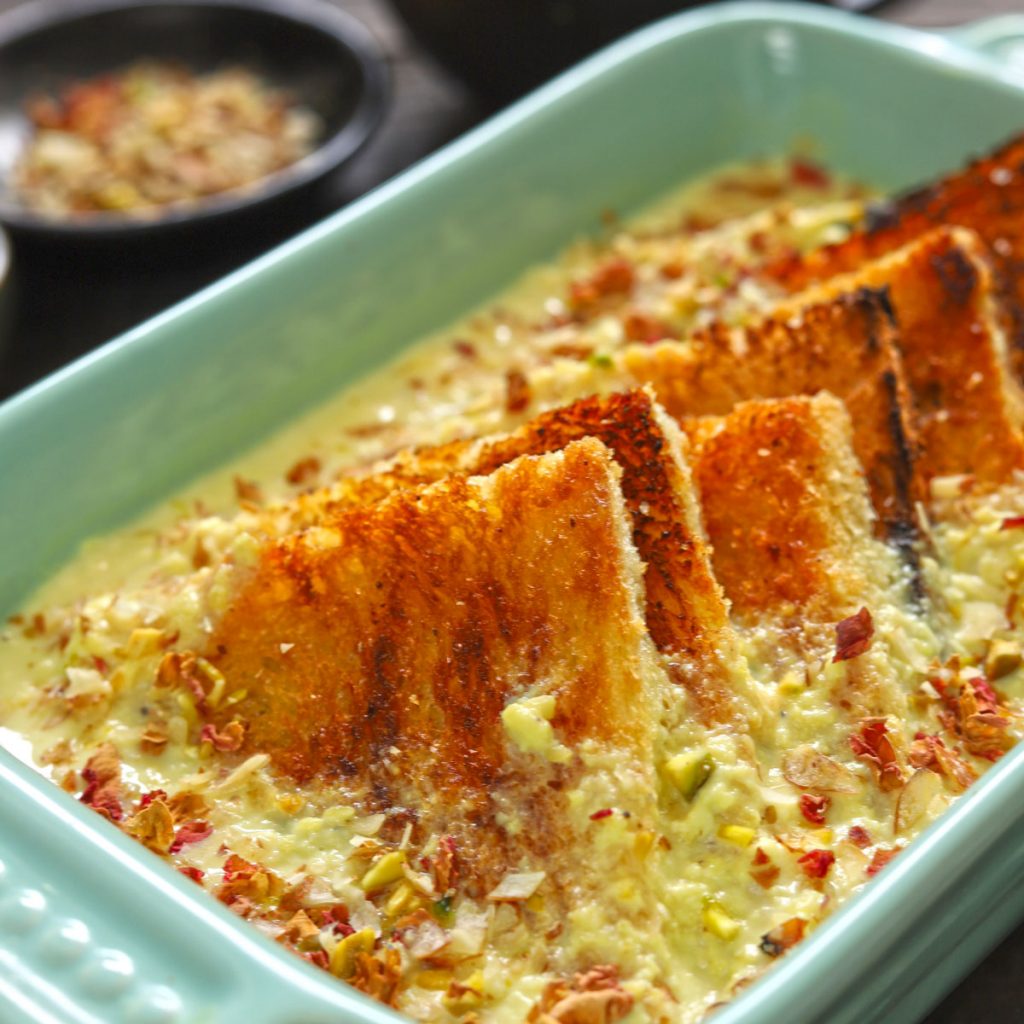Shahi Tukra: A Culinary Odyssey Through Mughal Splendor
Shahi Tukra, a luscious dessert resonating through the kitchens of India, Pakistan, and Bangladesh, has a riveting history deeply rooted in the extravagant culture of the Mughals. This delectable treat, synonymous with festivities like Eid, Diwali, and weddings, has become a symbol of indulgence and luxury. Let's delve into the origins of Shahi Tukra, a culinary gem born from the grandeur of the Mughal Empire.
The Mughal Empire's Culinary Extravagance:
The Mughal Empire, a powerhouse dynasty spanning the 16th to the 19th century in South Asia, left an indelible mark on history. Renowned for artistic achievements, architectural marvels, and a penchant for luxury, the Mughals elevated their legacy through a distinctive cuisine. A fusion of Persian, Turkish, Central Asian, and Indian influences resulted in a rich tapestry of aromatic and flavorful dishes. Their banquets, a testament to opulence, showcased exotic ingredients like saffron, rose water, and an assortment of nuts.
The Birth of Shahi Tukra: A Regal Creation:
Among the treasures of Mughal cuisine, Shahi Tukra stands out, signifying a "royal piece" or a "royal bite." Legend has it that this sumptuous dessert was birthed by the ingenious chefs of Mughal Emperor Shah Jahan, the visionary behind the Taj Mahal. Shah Jahan's insatiable sweet tooth led his chefs to innovate constantly. One day, a chef dared to transform leftover bread, often discarded, into a culinary masterpiece. The bread, cut into pieces, was fried in ghee until golden, then soaked in sugar syrup, and smothered in a creamy milk mixture infused with saffron, cardamom, and rose water. Garnished with nuts and adorned with silver or gold leaf, Shahi Jahan was so enchanted that he christened it Shahi Tukra. This decree ensured its presence at every royal feast, crafted only with the finest ingredients.
The Many Faces of Shahi Tukra: Regional Variations:
Shahi Tukra, an epitome of culinary diversity within Mughal cuisine, has evolved across regions and communities, adapting to local tastes. In Hyderabad, once part of the Mughal Empire, it transforms into "double ka meetha." The bread, known as "double roti," swells to double its size after baking. Soaked in milk rather than sugar syrup, this variant includes khoya and condensed milk for a richer texture. Served with custard or rabri, and adorned with nuts and dried fruits, it's a testament to the dish's versatility.
Another variation, "umm ali," meaning "mother of Ali" in Arabic, is a revered dessert in Egypt and the Middle East. Though its origin is attributed to the Mughals, it tells a tale of alleged violence. Baked with milk, sugar, nuts, raisins, and coconut, umm ali is served hot or cold, often with whipped cream or vanilla ice cream.
Shahi Tukra: Beyond Dessert – A Cultural Heritage:
Shahi Tukra transcends its role as a mere dessert, embodying the grandeur of the Mughal Empire and the diverse creativity within Mughal cuisine. Surviving centuries, it has found a place in the hearts and kitchens of varied communities. Simple yet elegant, humble yet regal, sweet yet satisfying, Shahi Tukra truly lives up to its royal name.
Conclusion:
In savoring Shahi Tukra, one doesn't just indulge in a delightful dessert; they partake in a journey through Mughal history. From royal courts to diverse kitchens, this dish weaves stories of empires, culinary innovation, and shared joy. Shahi Tukra stands not just as a dessert but as a cultural icon, a sweet testament to the resilience and evolution of South Asian culinary heritage.
Now to the fun part
Shahi Tukra Vs. Scientific Theories
Much like scientific theories unravel the mysteries of the universe, Shahi Tukra unveils the chemistry of flavors. The crisp bread, soaked in saffron-infused milk, represents a delicate balance akin to the intricate dance of particles in scientific realms. This symphony of ingredients, including cardamom and nuts, creates a harmonious blend that tantalizes taste buds, aligning with the precision of scientific principles.
Shahi Tukra Vs. Sociological Theories
Shahi Tukra transforms into a sociological metaphor, encapsulating the essence of human connection. The unification of fried bread slices symbolizes individuality, while the shared experience of relishing this dessert mirrors the interconnectedness within society. Sociological theories often explore the dynamics of relationships, and Shahi Tukra, in its communal nature, becomes a tangible representation of shared moments and social bonds.
Shahi Tukra Vs. Historical Events
Delving into history, Shahi Tukra emerges as a culinary relic echoing the grandeur of the Mughal Empire. Originating from the kitchens of Emperor Shah Jahan, the dessert bears witness to an era defined by opulence, architectural marvels, and a fusion of cultures. Each bite encapsulates the historical legacy of a dynasty that left an indelible mark on South Asian history.
Regional variations of Shahi Tukra offer diverse historical narratives. The Hyderabadi adaptation, known as double ka meetha, reflects the cultural intermingling during the Nizam rule. Umm Ali, an Egyptian variant, believed to have Mughal origins, whispers tales of Middle Eastern history. These adaptations transcend culinary evolution, acting as palatable chapters in the historical novel of Shahi Tukra.
In the realm of culinary treasures, Shahi Tukra reigns as an ambassador of Mughal opulence, transcending its status as a mere dessert. From the regal courts of Emperor Shah Jahan to the diverse kitchens of today, this luscious treat weaves stories of empires, cultural evolution, and shared joy. Beyond its decadent layers, Shahi Tukra stands as a cultural icon, a testament to the resilience and creativity embedded in South Asian culinary heritage. As we relish each bite, we not only savor a delightful dessert but embark on a flavorful journey through history, science, and the intricacies of human connections. Shahi Tukra, with its royal pedigree, remains an ever-relevant symbol of the rich and diverse tapestry of Mughal culinary legacy.
Peace Out

Comments
Post a Comment